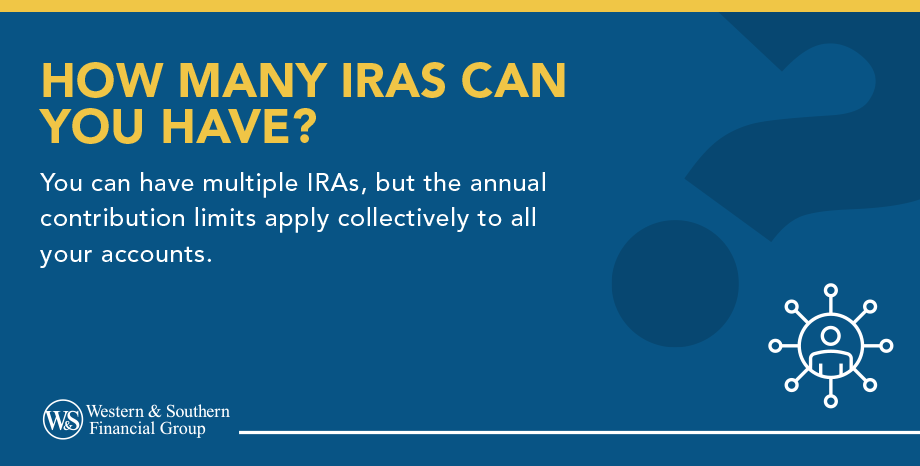Table of Contents
Table of Contents


Key Takeaways
- The IRS does not impose a restriction on the number of IRAs an individual can own, which you are free to open multiple IRAs to suit your retirement savings strategy.
- Although there is no limit on the number of IRAs you can have, there are contribution limits set by the IRS on the total amount of money you can contribute to all your IRAs combined.
- Owning multiple IRAs can provide benefits such as investment diversification across different financial institutions or asset types, potential tax advantages based on the type of IRA, inheritance planning for beneficiaries, and increased flexibility in managing early withdrawals based on your retirement goals and needs.
Are you looking ahead to plan for your financial future? When considering ways to save for retirement, individual retirement accounts (IRAs) might be worth investigating.
If you're interested in saving outside an employer-sponsored 401(k) plan, you could turn to IRAs to help boost retirement savings for the long term.
Understanding IRA Limits
The IRS sets no cap on the number of IRAs you can own. However, there is a limit set on the amount of money you can contribute in total to your IRAs, regardless of whether they're Roth or traditional accounts.
The IRS currently caps contributions to Roth and traditional IRAs at $7,000 per year for those under 50. If you're 50 and older, that limit increases to $8,000. The extra $1,000 is called a catch-up contribution.1
The same rules apply for Roth IRAs. For 2025, the maximum contribution level is set at either $7,000 or $8,000, depending on your age. While there is no limit to the number of Roth IRAs you can own, you can't go over the contribution limits set by the IRS.
Roth IRAs vs. Traditional IRAs: What's the Difference?
The term "IRA" often gets thrown around as a catch-all phrase. While a Roth IRA and a traditional IRA are similar, there are key differences to understand as you start saving.
A Roth IRA is a retirement account with after-tax benefits. When it comes time to start withdrawing from your Roth IRA, at age 59½, disbursements are typically not taxed. If you withdraw earnings before that age, you may face both a 10% early withdrawal penalty and have to pay taxes on the amount withdrawn.
A traditional IRA offers pretax benefits. Any growth and interest gained over the years are tax-deferred while in the account. Once you hit 59½ and begin making withdrawals, those distributions would be taxed at your current income level's tax rate. Withdrawals made prior to age 59½ will be taxed at your present income rate and incur an additional 10% early distribution penalty.
As long as you keep funds in your account until you are 59½ and meet related requirements, you will not have to pay penalties on withdrawals from a Roth or traditional IRA.
Why Would You Consider Multiple IRAs?
You might wonder why someone would consider having multiple IRAs if there is a relatively small limit on the contributions. There are a few reasons why it might make sense for some to take that approach versus having just one account.
Here are a few of the potential benefits and reasons why you might want to have multiple IRAs:
Investment Diversification
Diversification is often a key part of a retirement strategy. Having multiple IRAs allows you to put your funds in different financial institutions or different types of investments. However, diversification cannot guarantee profit or protection against loss in a declining market.
Tax Diversification
Depending on the type of IRA you choose, you could potentially see different tax benefits. Using a mix of multiple IRAs means you might maximize some of your tax opportunities in retirement.
Inheritance and Estate Planning
Some people choose to have a few IRAs to cover each of their children. That can help to make future estate planning more straightforward, as each child has their own IRA inheritance.
Potential Withdrawal Flexibility
The rules around withdrawals vary between IRA types. Roth and traditional IRAs each have some benefits. Depending on your plan for retirement, you could potentially have more flexibility for making early withdrawals if you need to.
You'll also want to consider some of the potential cons or disadvantages of having multiple IRAs before pursuing that strategy. For instance, it could be difficult to manage multiple IRA accounts, might require more funds upfront (to satisfy minimum balance requirements) and can potentially create more fees at withdrawal.
Should You Have Multiple IRAs?
The answer ultimately depends on your individual needs and retirement plans. For some, it may make sense to maintain multiple accounts, while for others a more straightforward path may be better.
As you explore your options with IRAs, consider your short and long-term needs and determine the best path for you. Working with a knowledgeable and experienced financial professional can help you identify your goals and chart a course toward them.
Choose an IRA that may best fit for your retirement strategy. Start Your Free Plan
Sources
- 401(k) limit increases to $23,500 for 2025, IRA limit remains $7,000. https://www.irs.gov/newsroom/401k-limit-increases-to-23500-for-2025-ira-limit-remains-7000.





















